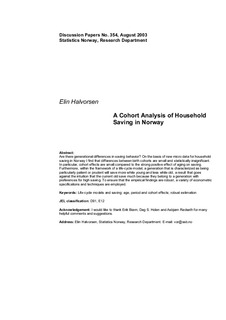| dc.contributor.author | Halvorsen, Elin | |
| dc.date.accessioned | 2011-11-25T15:00:20Z | |
| dc.date.available | 2011-11-25T15:00:20Z | |
| dc.date.issued | 2003 | |
| dc.identifier.issn | 1892-753x | |
| dc.identifier.uri | http://hdl.handle.net/11250/180457 | |
| dc.description.abstract | Abstract:
Are there generational differences in saving behavior? On the basis of new micro data for household saving in Norway I find that differences between birth cohorts are small and statistically insignificant. In particular, cohort effects are small compared to the strong positive effect of aging on saving. Furthermore, within the framework of a life-cycle model, a generation that is characterized as being particularly patient or prudent will save more while young and less while old, a result that goes against the intuition that the current old save much because they belong to a generation with preferences for high saving. To ensure that the empirical findings are robust, a variety of econometric specifications and techniques are employed. __ Keywords: Life-cycle models and saving; age, period and cohort effects; robust estimation | no_NO |
| dc.language.iso | eng | no_NO |
| dc.publisher | Statistics Norway, Research Department | no_NO |
| dc.relation.ispartofseries | Discussion Papers;No. 354 | |
| dc.subject | Savings | no_NO |
| dc.subject | Household savings | no_NO |
| dc.subject | Norway | no_NO |
| dc.subject | Life-cycle models | no_NO |
| dc.subject | JEL classification: D91 | no_NO |
| dc.subject | JEL classification: E12 | no_NO |
| dc.title | A cohort analysis of household saving in Norway | no_NO |
| dc.type | Working paper | no_NO |
| dc.subject.nsi | VDP::Social science: 200::Economics: 210::Economics: 212 | no_NO |
| dc.source.pagenumber | 41 s. | no_NO |
